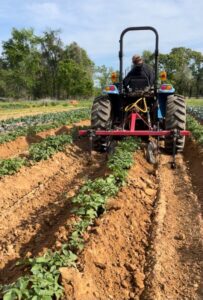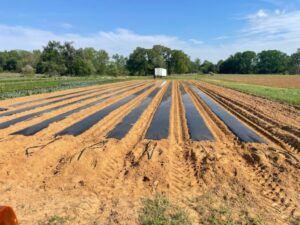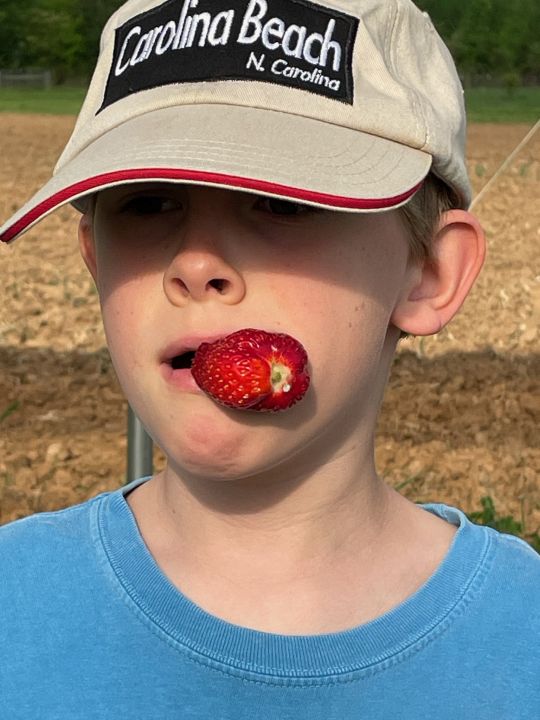Hilling taters and planting maters

The past week has been full of activity! There is lots of farm news from these busy busy farmers.
Randy hilled the potatoes. If you are unfamiliar with the specifics of potato growing, “hilling” means piling up dirt around the base of the plant. Potatoes are not grow from seed, but rather from pieces of a potato. If your kitchen management is anything like ours, you’re probably familiar with how the eyes of potatoes sprout and begin to grow. We can’t plant the seed potato too deep in the ground or it will be too wet and rot before it can sprout and grow. But every new potato the plant produces is located above the seed potato. Which means sometimes they break through the soil surface. This exposes the tubers to sunlight and spurs the production of solanine, a toxin found in various parts and quantities in all members of the potato’s family (tomatoes, eggplant, peppers, tobacco, and belladonna, to name a few). This turns the potatoes green and turns them from food to not food. The more soil we mound up on the plants, the more likely all the new potatoes will stay tucked under their soil blanket.
On Saturday, while I was at the farmers market, and with the help of Robin and Joseph, Randy shaped the first beds for “summer” crops. We didn’t waste any times

getting them planted. Monday morning we seeded green beans and transplanted basil, eggplant, and the first 350 tomato plants.
Cucumber conundrum
I also threw away all our cucumber plants. I noticed some of the cucumbers in the greenhouse starting to wilt. Upon closer inspection there were tiny insect larva on the roots and filling the stems! It was not something I recognized or had seen before. In an abundance of caution I bagged the plants and threw them in the trash. 99.9% of the time plants get composted. I think this is the first time I have ever thrown plants in the trash.
On Monday I took some samples of the plants and larvae to our agricultural extension agent, Roy, who contacted one of the state entomologists for a diagnosis. Fungus gnat larva. Sure, I’d seen the odd fungus gnat here or there. They are a common greenhouse pest. But apparently the conditions in those cucumber trays set the stage for a fungus gnat explosion!
In some ways, the diagnosis was good news. Fungus gnats are not a problem in the garden, only the greenhouse. But it is a wake up call – we need to be more proactive about our fungus gnat control to avoid a situation like this in the future! For now, we seeded the cucumbers directly into the high tunnel beds rather than reseeding in the greenhouse. I am also everything in the greenhouse dry nearly to wilting before watering because fungus gnats like wet conditions. We will be doing more research about organic control and prevention methods. Farm fails are just opportunities to learn more.
Keeping your greens fresh!
Several years ago we transitioned away from single use plastic in our farmers market and CSA packaging. BioBags are great for individually portioning out your greens without single use plastic. However, they are more permeable than plastic, and as a result your greens will wilt more quickly in a Biobag than a plastic bag. If you aren’t going to eat your biobagged produce within a day or two, consider storing it in plastic. The easiest way to do this is to put the whole bag into a gallon zipper storage bag or storage container (i.e. tupperware). You can reuse the plastic storage week after week. There are also several products on the market for green storage solutions. Happy crunching!
Small Shares
- strawberries
- lettuce mix
- bibb lettuce
- purple and green kohlrabi
- collard greens
Full shares
- turnips
- lettuce mix
- bibb lettuce
- purple and green kohlrabi
- collard greens
- chard

You must be logged in to post a comment.